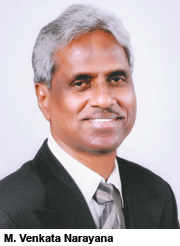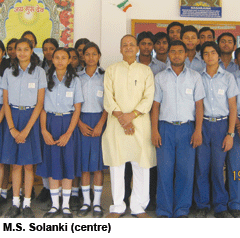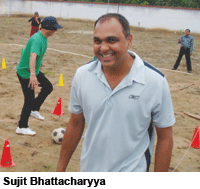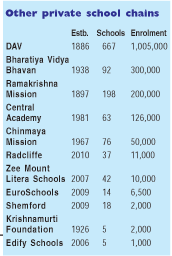Although India’s 80,000 recognised, private aided and unaided schools constitute 7 percent of the total number of primary-secondary schools in the country, they enroll and educate an estimated 42 percent of students (90 million) in the age group six-18. With India’s 1.25 million government primaries and secondary schools, characterised by abysmal learning outcomes, teacher truancy and inadequate infrastructure going from bad to worse, enrolment in private schools is steadily rising countrywide, even in the rural hinter-land. (According to the Annual Status of Education Report 2010, private school enrolment in rural India has risen from 16.3 percent in 2005 to 24.3 percent in 2010).
Responding to the rising tide of public demand for qualitatively superior primary-secondaries, a growing number of can-do educationists and edupre-neurs, determined to navigate their way through the red tape and elaborate rules and regulations devised by the Central and state governments to discourage edupreneurs, are establishing greenfield schools countrywide — from budget, affordable, mid-market to high-end international schools. EW presents snapshot profiles of some private educationists who are changing the face of school education.
Ryan International Group of Institutions
.gif) Started modestly as a single-teacher school by Dr. Augustine and Mme Grace Pinto in 1976, the Mumbai-based Ryan International Group of Instit-utions (RIGI) has flowered into India’s largest and fastest growing private sector proprietorial — i.e excluding franchise — schools chain. Currently, RIGI comprises 120 K-12 schools in 40 cities across India with an aggregate enrolment of 240,000 students and 15,000 teachers. In particular, during the past five years the number of schools promoted by RIGI has increased from 96 to 120 with five of them becoming operational in the past 12 months, and system-wide RIGI receives an average of ten applications for every vacant seat in its schools across the country. The great, unacknowledged contribution of Indian school education’s fastest growing group is that it has brought highly-prized, quality English-medium ‘convent’ school education within reach of the country’s rapidly expanding new middle class.
Started modestly as a single-teacher school by Dr. Augustine and Mme Grace Pinto in 1976, the Mumbai-based Ryan International Group of Instit-utions (RIGI) has flowered into India’s largest and fastest growing private sector proprietorial — i.e excluding franchise — schools chain. Currently, RIGI comprises 120 K-12 schools in 40 cities across India with an aggregate enrolment of 240,000 students and 15,000 teachers. In particular, during the past five years the number of schools promoted by RIGI has increased from 96 to 120 with five of them becoming operational in the past 12 months, and system-wide RIGI receives an average of ten applications for every vacant seat in its schools across the country. The great, unacknowledged contribution of Indian school education’s fastest growing group is that it has brought highly-prized, quality English-medium ‘convent’ school education within reach of the country’s rapidly expanding new middle class.
Excerpts from an interview with Mme. Grace Pinto, promoter-managing director of RIGI.
How satisfied are you with the progress of RIGI?
Over the past three decades, we have achieved a great deal. RIGI schools are spread across the country and offer a diverse range of exam board affiliations including CBSE, CISCE, IB, IGCSE and SSC. We are happy and grateful that we have achieved substantial success. The vision of Dr. Augustine F. Pinto, our chairman, is to provide affordable, high quality education in all corners of the country. In that sense, we still have a long way to go.
What would you say is the most significant impact of the Ryan Group on K-12 education?
Ryan is today recognised and acknowl-edged as a leader in K-12 education both in terms of the number of schools we run and the quality of education we provide. We ensure that RIGI students receive holistic education — academic, cultural, extra-curricular and moral. A progressive institution, RIGI has pioneered many initiatives which have now become education benchmarks. For instance, the Indian Model United Nations and International Children’s Theatre Festivals, organised annually by RIGI, are international events attracting students from India and abroad. The overwhelming response from students and parents for admission into our schools countrywide is testimony to the impact of RIGI on K-12 education.
What are your future plans?
We want to take quality, English-medium education to the farthest corners of India, to enable access by all segments of society. We are also engaged with integrating technology into delivery processes, and are venturing into higher education and overseas expansion.
Delhi Public Schools
.gif) In the six decades since the Delhi Public Schools Society (estb.1937) promoted its pioneer Delhi Public School (DPS), Mathura Road in 1949, the number of DPS owned/franchised schools in India and abroad has risen to 140, with an aggregate enrolment of 275,000 students instructed by an estimated 10,000 teachers. Today they serve as model institutions for K-12 day schools, being the most preferred choice of India’s upwardly mobile urban middle class.
In the six decades since the Delhi Public Schools Society (estb.1937) promoted its pioneer Delhi Public School (DPS), Mathura Road in 1949, the number of DPS owned/franchised schools in India and abroad has risen to 140, with an aggregate enrolment of 275,000 students instructed by an estimated 10,000 teachers. Today they serve as model institutions for K-12 day schools, being the most preferred choice of India’s upwardly mobile urban middle class.
The excellent reputation of DPS schools is testified by the inclusion of 19 DPS primary-secondaries headed by DPS, R.K. Puram, Delhi in the India’s Most Respected Schools Survey 2011 league table of 176 day schools countrywide, published by EducationWorld (EW September 2011).
Excerpts from an interview with Ashok Chandra, chairman of DPS Society.
What in your opinion are the different-iating characteristics of DPS K-12 education?
We aim for the highest standards of excellence and provide our students access to the best opportunities for all-around growth and advancement. Moreover, DPS students everywhere are encouraged to discover themselves in facilitating environments, and grow into confident and progressive indivi-duals with the knowledge and skills to shape their lives. We offer best faculty, state-of-the-art infrastructure, activity-based pedagogies, excellent sports facilities and a wide range of co-curricular education options. All this results in academic excellence which is widely admired.
How satisfied are you with the pace of growth of DPS?
I am of the view that all Delhi Public Schools are doing very well. Developing good schools is not easy and the people involved in the exercise have to be deeply motivated.
What are the future growth and development plans of the DPS Society?
The DPS development model necessi-tates active involvement of the DPS society with all affiliated schools under the DPS brand umbrella. This model has enabled us to ensure uniform standardi-sation and maintain the reputation of the DPS brand. Spreading quality education to every nook and corner of the country, especially to remote and neglected areas, is an objective which will be pursued with the same passion that we have shown in establishing schools in locations like Leh and other places in Jammu & Kashmir, Assam, Rajasthan etc.
Gowtham Model Schools
 Promoted in 2002 with the mandate to offer affordable quality education, the Hyderabad-based Gowtham Model Schools group has grown rapidly to establish 70 K-10 schools with an aggregate enrolment of 50,000 students and 3,000 teachers in 48 towns and cities across the southern state of Andhra Pradesh (pop. 84 million).
Promoted in 2002 with the mandate to offer affordable quality education, the Hyderabad-based Gowtham Model Schools group has grown rapidly to establish 70 K-10 schools with an aggregate enrolment of 50,000 students and 3,000 teachers in 48 towns and cities across the southern state of Andhra Pradesh (pop. 84 million).
Affiliated with the Andhra Pradesh state exam board, all Gowtham Model Schools offer technology-enabled English-medium K-10 education on contemporary campuses for Rs.1,000-1,500 per month. Now the group, which also runs ten junior (classes XI-XII) colleges and a CBSE-affiliated Orchid International School, is going national with its affordable schools model, and has set a target of launching 250 schools in Madhya Pradesh, Mahar-ashtra, Gujarat and Rajasthan.
M. Venkata Narayana is the Hyderabad-based founder chairman of K-12 Techno Services Pvt. Ltd, which offers education consultancy services to all Gowtham Model Schools (GMS).
What is the USP of Gowtham Model Schools?
We offer high-quality technology-enabled education at affordable tuition fees of Rs.1,000-1,500 per month. There’s huge demand from parents for reasonably priced good quality education, as they cannot afford Rs.50,000-1 lakh per year tuition fees that high-end private schools levy, and are unwilling to enroll their children in free government schools because of their poor learning outcomes. I believe we have significantly impacted the K-12 education sector by enabling over 50,000 children to access affordable high-quality school education.
How satisfied are you with the pace of growth of GMS?
Though we have done well to expand our network of schools across Andhra Pradesh in a short span of time, I am not fully satisfied. I want to start GMS schools in every nook and corner of the country so that all children can access quality education.
How enabling are state government policies for establishing new K-12 schools?
To some extent, the state government has facilitated our growth. There is adequate awareness within govern-ment that its schools are unable to deliver results, and that there’s a public shift towards private education.
Your future plans.
By 2015, we have set a target of promoting 250 schools in four states — Maharashtra, Gujarat, Rajasthan and Madhya Pradesh. We have been able to persuade investors to share our vision. In September last year, Sequoia Capital and Song Advisors invested Rs.70 crore in K-12 Techno Services and recently, books publishing major Navneet Publications has come aboard as an investor.
Maharishi Vidya Mandir Schools
 The first Maharishi Vidya Mandir (MVM) school was promoted in Bhopal in 1991 by the globally renowned transcendental meditation guru Maharishi Mahesh Yogi (1917-2008), under the aegis of the Maharishi Shiksha Sansthan. Since then, the MVM group has grown to 148 schools, of which 110 are affiliated with the CBSE, offering K-12 education to over 80,000 students in 118 cities countrywide. Affordably priced (tuition fees: Rs.250-1,000 per month) MVM schools have spearheaded the revival of culturally-rooted school education offering an alternative to Christian missionary schools.
The first Maharishi Vidya Mandir (MVM) school was promoted in Bhopal in 1991 by the globally renowned transcendental meditation guru Maharishi Mahesh Yogi (1917-2008), under the aegis of the Maharishi Shiksha Sansthan. Since then, the MVM group has grown to 148 schools, of which 110 are affiliated with the CBSE, offering K-12 education to over 80,000 students in 118 cities countrywide. Affordably priced (tuition fees: Rs.250-1,000 per month) MVM schools have spearheaded the revival of culturally-rooted school education offering an alternative to Christian missionary schools.
Excerpts from an interview with M.S. Solanki, director (academics and training) of the MVM group of schools.
What is the USP of MVM schools?
In MVM schools, a 20-minute transcendental meditation session is compulsory for all students and staff. MVM schools offer life-oriented education through delivery of balanced education with equal emphasis on academics, extra-curricular, sports and spiritually uplifting education.
How satisfied are you with the pace of growth of MVM?
Over the past two decades, we have grown to 148 schools spread over 16 states with an enrolment of 80,000 students and 7,000 teachers. That’a a good — even if not entirely satisfactory — rate of growth.
How enabling are Central and state government policies for establishing new schools?
We’ve had no problem with either the Central or state governments about establishing new schools. By the grace of Maharishiji, everything goes well for us. We are also in favour of the RTE Act and have admitted deserving students as per its provisions.
What are your future growth and development plans?
We plan to spread our message by franchising our pre-primary schools branded Maharishi Kids Home as well as our secondary and senior secondary schools. Moreover, our Maharishi University, Fairfield, Iowa (USA) is planning to start an Indian campus very soon.
Indus World Schools
 Promoted by CL Educate (formerly Career Launcher, estb.1995), one of India’s largest test prep companies with over 225 coaching centres in 175 cities, the Indus World Schools (IWS) chain has rapidly scaled up to 17 schools with an aggregate enrolment of 5,000 students in eight states. Led by a team of IIT and IIM alumni, this “career-centric chain of schools” has broken new ground by importing best corporate and organisational practices into K-12 education, and in particular curriculum planning, teacher development and career guidance. Additionally, under its Bottom of Pyramid (BOP) schools initiative, the group has promoted nine low-cost schools in four districts of rural Andhra Pradesh.
Promoted by CL Educate (formerly Career Launcher, estb.1995), one of India’s largest test prep companies with over 225 coaching centres in 175 cities, the Indus World Schools (IWS) chain has rapidly scaled up to 17 schools with an aggregate enrolment of 5,000 students in eight states. Led by a team of IIT and IIM alumni, this “career-centric chain of schools” has broken new ground by importing best corporate and organisational practices into K-12 education, and in particular curriculum planning, teacher development and career guidance. Additionally, under its Bottom of Pyramid (BOP) schools initiative, the group has promoted nine low-cost schools in four districts of rural Andhra Pradesh.
Excerpts of an interview with Sujit Bhattacharyya, an alumnus of IIT-Kharagpur and IIM-Bangalore, and co-founder and CEO of school education at CL Educate.
How satisfied are you with the progress of IWS?
In five years, we have established 17 schools with over 5,000 students in eight states. For a chain which started with a modest capital base, we are quite pleased with our growth so far. What gives us greatest satisfaction is the joy with which children look forward to coming to school each day, and the high quality of parental response.
How easy is it to grow and develop in this segment?
This segment is very challenging because of the linkages to real estate and huge capital investment. Several big players are eyeing an entry into school education and hence the sector will become very competitive.
What would you say is the most significant impact of IWS on K-12 education?
Indus has made a number of innovations in the K-12 education space by introducing world-class practices to develop a progressive organisation culture of openness and learning. But the most visible impact of Indus will perhaps be in the last mile of K-12 education which will connect students with their career choices.
What are your future plans?
Our target is 75 IWS schools country-wide in the next five years, reaching out to over 30,000 students.
